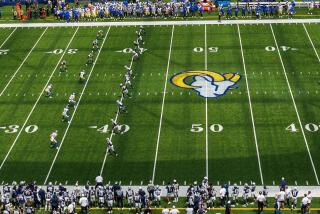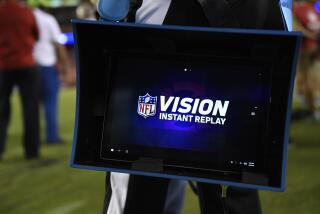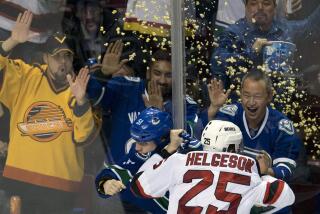The NHL / Julie Cart : League Gets Aggressive Against the Aggressors
- Share via
The National Hockey League’s board of governors last week approved several rules changes, electing to keep most of the experimental anti-violence rules used during the exhibition season.
The intent of the changes is to tell players that fighting, high sticking and slashing will not be tolerated. Game officials have been instructed to “go by the book” in calling penalties and to identify the aggressor in fights.
“The difference this year is that the referee is going to be more stringent in enforcing the rules,” said Gerry McNamara, Toronto Maple Leaf general manager. “The league is going to do away with one guy being able to go out there and take a good player out of the game.”
Teams with valuable players, such as the Edmonton Oilers with Wayne Gretzky, usually puts its star on a line with “bodyguards” to protect the star from “goons.”
Under the new rules, an official may add an extra minor, major or game misconduct penalty to the original fighting major against a player who is deemed the aggressor in a fight. The rules, however, also penalize those who retaliate.
That rankles King Coach Pat Quinn.
“I really don’t think they know how to call these rules yet,” Quinn said. “They want to stop fights and penalize the aggressor. But it’s just going to let some guy come in and take a cheap shot. The clean player who defends himself will have to pay. I just don’t think it will accomplish what they want.”
If a player gets two aggression penalties during a game, even minors, he will be automatically ejected.
High sticking and slashing are under attack as well. Under the new rules, just carrying the stick above shoulder height may produce a minor penalty. If the player makes contact with another, the penalty becomes a double minor. If an injury occurs, a major or game penalty will be assessed. And if a player gets two major high-sticking penalties, a game misconduct will be added.
Slashing is treated the same as high sticking.
Quinn does not mean to imply by his objections that he’s in favor of fighting. With the exception of Dave (Tiger) Williams, there are no real brawlers on the King team. And the stars players can take care of themselves.
What Quinn, and others, object to are rules that are more cosmetic than therapeutic. Fighting in hockey needs to be stopped. Whether the new rules will achieve that remains to be seen.
Things just don’t seem to settle down in St. Louis. The Blues were sold earlier this month for $19 million to a group of St. Louis investors headed by businessman Michael Shanahan.
Now it appears that there is interest in moving the team to Milwaukee.
The Milwaukee Journal reported that Lloyd and Jane Pettit had offered to buy an interest in the Blues and eventually move the team to Milwaukee.
The Pettits recently donated the $35-million Bradley Center arena to the city. The complex is scheduled to open in 1988. The thinking is that when the Pettits eventually had controlling shares, the Blues would move to Milwaukee and into the new arena.
The Pettits withdrew the offer, however, when the NHL would not guarantee that they would be allowed to transfer the club to Milwaukee.
An attorney for the Pettits, Joseph Tierney, said he had not formally asked the league for permission to move the Blues but had spoken informally with members of the NHL board of governors.
“I know perfectly well that the answer would be, ‘When you get ready, we’ll talk about it.’ But you don’t risk that kind of money with that kind of problem.”
The NHL is the only other professional sport to try instant replays to assist officials. The system was used in some games during the exhibition season to help the referee determine whether the puck went into the goal, the only situation in which the replay was allowed.
Unlike the NFL, however, the NHL cameras were independent of local and network coverage.
More to Read
Go beyond the scoreboard
Get the latest on L.A.'s teams in the daily Sports Report newsletter.
You may occasionally receive promotional content from the Los Angeles Times.







